Cross-Cultural Management: Theories and Global Teams
VerifiedAdded on 2023/01/12
|16
|5511
|26
Report
AI Summary
This report provides a comprehensive analysis of cross-cultural management within an international business context. It begins by highlighting the importance of cross-cultural understanding in today's globalized world, emphasizing its impact on resolving conflicts, enhancing customer target...
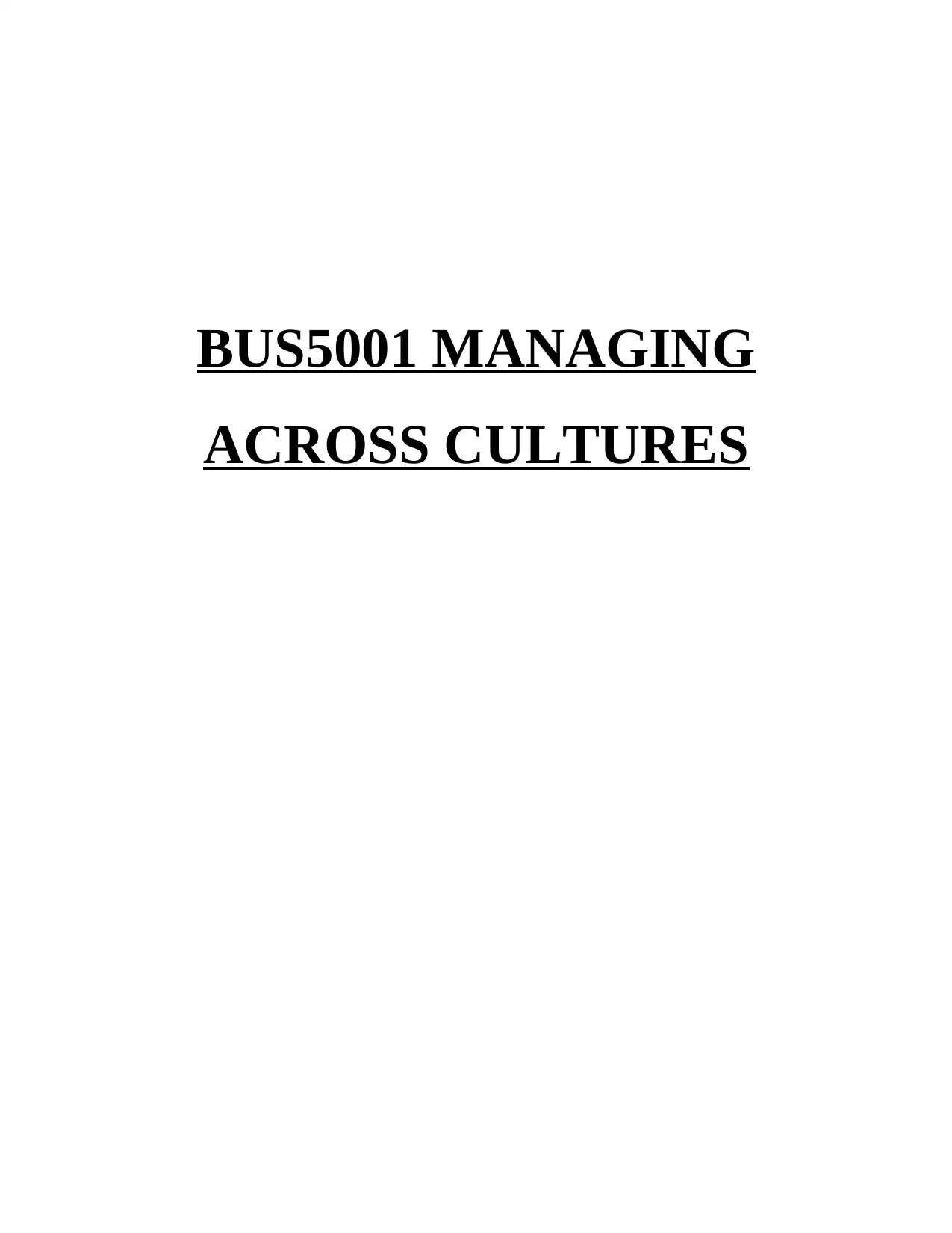
BUS5001 MANAGING
ACROSS CULTURES
ACROSS CULTURES
Secure Best Marks with AI Grader
Need help grading? Try our AI Grader for instant feedback on your assignments.
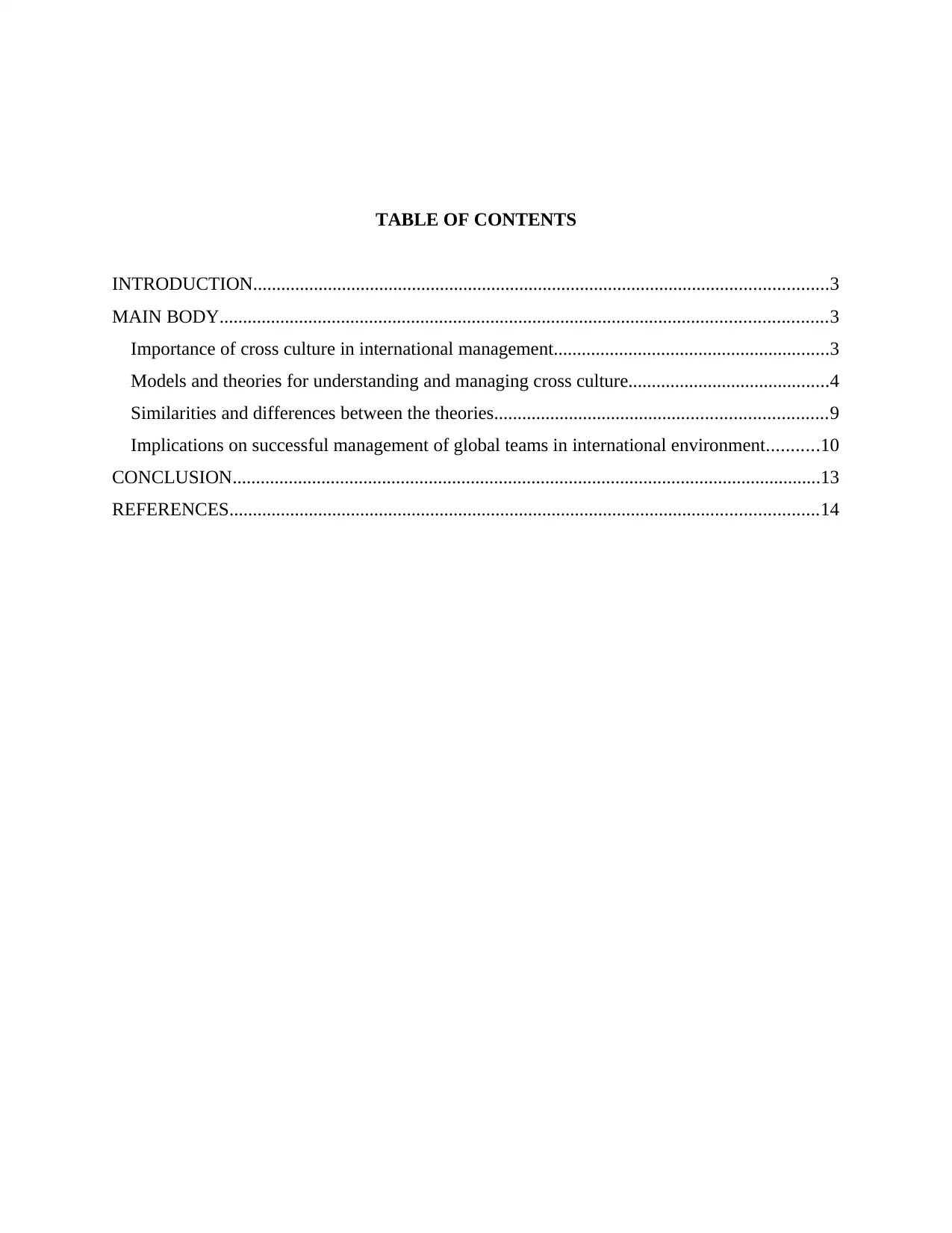
TABLE OF CONTENTS
INTRODUCTION...........................................................................................................................3
MAIN BODY..................................................................................................................................3
Importance of cross culture in international management...........................................................3
Models and theories for understanding and managing cross culture...........................................4
Similarities and differences between the theories.......................................................................9
Implications on successful management of global teams in international environment...........10
CONCLUSION..............................................................................................................................13
REFERENCES..............................................................................................................................14
INTRODUCTION...........................................................................................................................3
MAIN BODY..................................................................................................................................3
Importance of cross culture in international management...........................................................3
Models and theories for understanding and managing cross culture...........................................4
Similarities and differences between the theories.......................................................................9
Implications on successful management of global teams in international environment...........10
CONCLUSION..............................................................................................................................13
REFERENCES..............................................................................................................................14
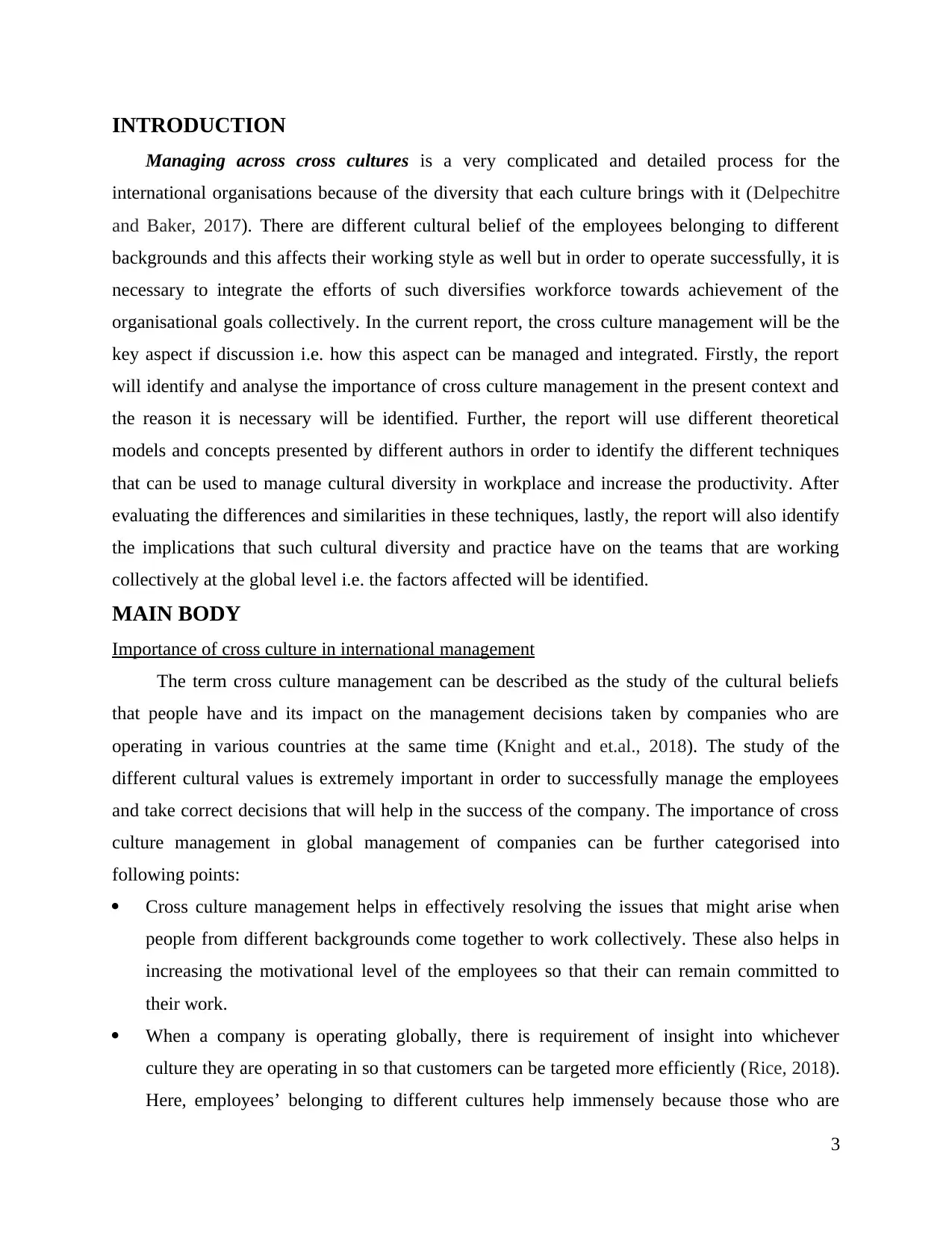
INTRODUCTION
Managing across cross cultures is a very complicated and detailed process for the
international organisations because of the diversity that each culture brings with it (Delpechitre
and Baker, 2017). There are different cultural belief of the employees belonging to different
backgrounds and this affects their working style as well but in order to operate successfully, it is
necessary to integrate the efforts of such diversifies workforce towards achievement of the
organisational goals collectively. In the current report, the cross culture management will be the
key aspect if discussion i.e. how this aspect can be managed and integrated. Firstly, the report
will identify and analyse the importance of cross culture management in the present context and
the reason it is necessary will be identified. Further, the report will use different theoretical
models and concepts presented by different authors in order to identify the different techniques
that can be used to manage cultural diversity in workplace and increase the productivity. After
evaluating the differences and similarities in these techniques, lastly, the report will also identify
the implications that such cultural diversity and practice have on the teams that are working
collectively at the global level i.e. the factors affected will be identified.
MAIN BODY
Importance of cross culture in international management
The term cross culture management can be described as the study of the cultural beliefs
that people have and its impact on the management decisions taken by companies who are
operating in various countries at the same time (Knight and et.al., 2018). The study of the
different cultural values is extremely important in order to successfully manage the employees
and take correct decisions that will help in the success of the company. The importance of cross
culture management in global management of companies can be further categorised into
following points:
Cross culture management helps in effectively resolving the issues that might arise when
people from different backgrounds come together to work collectively. These also helps in
increasing the motivational level of the employees so that their can remain committed to
their work.
When a company is operating globally, there is requirement of insight into whichever
culture they are operating in so that customers can be targeted more efficiently (Rice, 2018).
Here, employees’ belonging to different cultures help immensely because those who are
3
Managing across cross cultures is a very complicated and detailed process for the
international organisations because of the diversity that each culture brings with it (Delpechitre
and Baker, 2017). There are different cultural belief of the employees belonging to different
backgrounds and this affects their working style as well but in order to operate successfully, it is
necessary to integrate the efforts of such diversifies workforce towards achievement of the
organisational goals collectively. In the current report, the cross culture management will be the
key aspect if discussion i.e. how this aspect can be managed and integrated. Firstly, the report
will identify and analyse the importance of cross culture management in the present context and
the reason it is necessary will be identified. Further, the report will use different theoretical
models and concepts presented by different authors in order to identify the different techniques
that can be used to manage cultural diversity in workplace and increase the productivity. After
evaluating the differences and similarities in these techniques, lastly, the report will also identify
the implications that such cultural diversity and practice have on the teams that are working
collectively at the global level i.e. the factors affected will be identified.
MAIN BODY
Importance of cross culture in international management
The term cross culture management can be described as the study of the cultural beliefs
that people have and its impact on the management decisions taken by companies who are
operating in various countries at the same time (Knight and et.al., 2018). The study of the
different cultural values is extremely important in order to successfully manage the employees
and take correct decisions that will help in the success of the company. The importance of cross
culture management in global management of companies can be further categorised into
following points:
Cross culture management helps in effectively resolving the issues that might arise when
people from different backgrounds come together to work collectively. These also helps in
increasing the motivational level of the employees so that their can remain committed to
their work.
When a company is operating globally, there is requirement of insight into whichever
culture they are operating in so that customers can be targeted more efficiently (Rice, 2018).
Here, employees’ belonging to different cultures help immensely because those who are
3
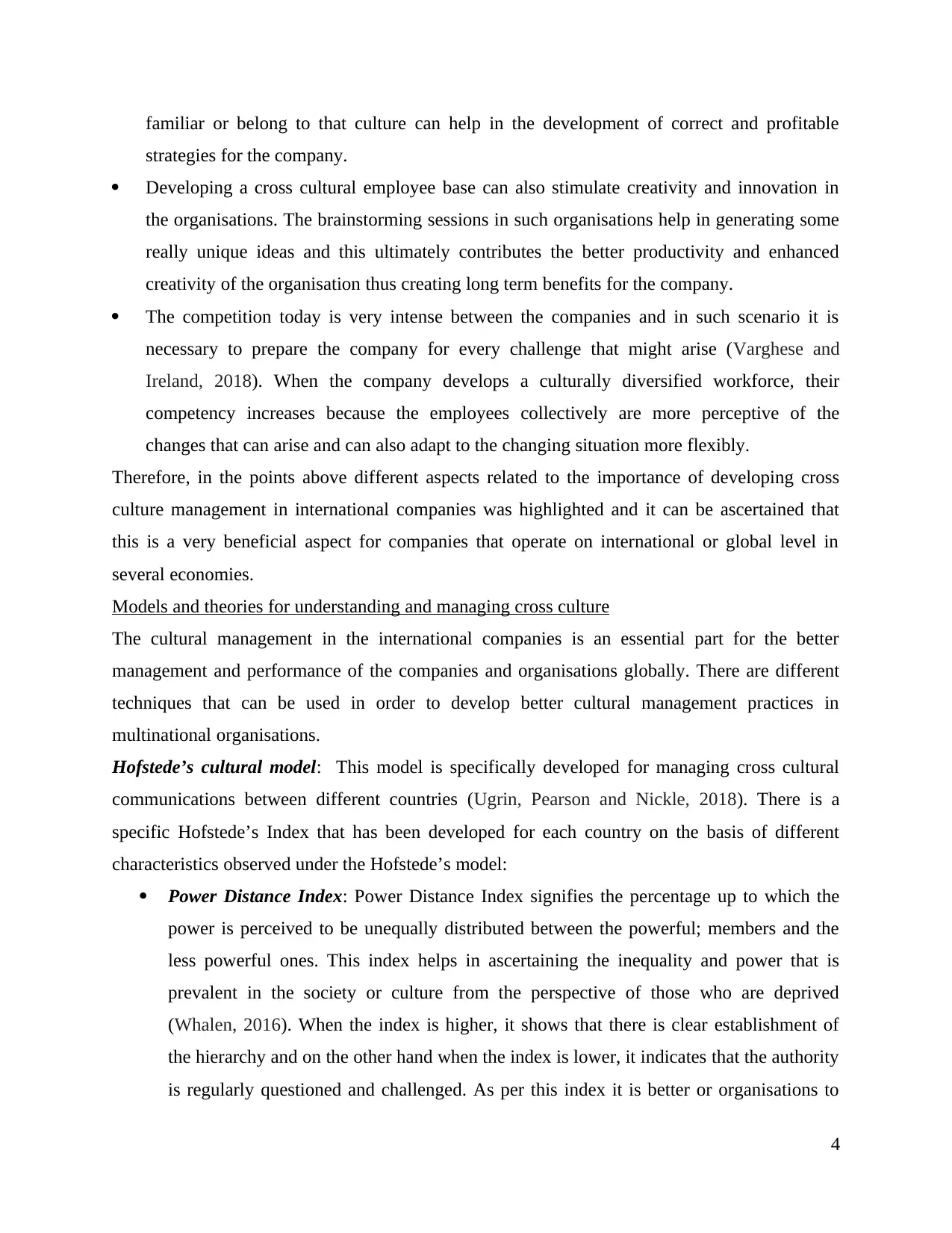
familiar or belong to that culture can help in the development of correct and profitable
strategies for the company.
Developing a cross cultural employee base can also stimulate creativity and innovation in
the organisations. The brainstorming sessions in such organisations help in generating some
really unique ideas and this ultimately contributes the better productivity and enhanced
creativity of the organisation thus creating long term benefits for the company.
The competition today is very intense between the companies and in such scenario it is
necessary to prepare the company for every challenge that might arise (Varghese and
Ireland, 2018). When the company develops a culturally diversified workforce, their
competency increases because the employees collectively are more perceptive of the
changes that can arise and can also adapt to the changing situation more flexibly.
Therefore, in the points above different aspects related to the importance of developing cross
culture management in international companies was highlighted and it can be ascertained that
this is a very beneficial aspect for companies that operate on international or global level in
several economies.
Models and theories for understanding and managing cross culture
The cultural management in the international companies is an essential part for the better
management and performance of the companies and organisations globally. There are different
techniques that can be used in order to develop better cultural management practices in
multinational organisations.
Hofstede’s cultural model: This model is specifically developed for managing cross cultural
communications between different countries (Ugrin, Pearson and Nickle, 2018). There is a
specific Hofstede’s Index that has been developed for each country on the basis of different
characteristics observed under the Hofstede’s model:
Power Distance Index: Power Distance Index signifies the percentage up to which the
power is perceived to be unequally distributed between the powerful; members and the
less powerful ones. This index helps in ascertaining the inequality and power that is
prevalent in the society or culture from the perspective of those who are deprived
(Whalen, 2016). When the index is higher, it shows that there is clear establishment of
the hierarchy and on the other hand when the index is lower, it indicates that the authority
is regularly questioned and challenged. As per this index it is better or organisations to
4
strategies for the company.
Developing a cross cultural employee base can also stimulate creativity and innovation in
the organisations. The brainstorming sessions in such organisations help in generating some
really unique ideas and this ultimately contributes the better productivity and enhanced
creativity of the organisation thus creating long term benefits for the company.
The competition today is very intense between the companies and in such scenario it is
necessary to prepare the company for every challenge that might arise (Varghese and
Ireland, 2018). When the company develops a culturally diversified workforce, their
competency increases because the employees collectively are more perceptive of the
changes that can arise and can also adapt to the changing situation more flexibly.
Therefore, in the points above different aspects related to the importance of developing cross
culture management in international companies was highlighted and it can be ascertained that
this is a very beneficial aspect for companies that operate on international or global level in
several economies.
Models and theories for understanding and managing cross culture
The cultural management in the international companies is an essential part for the better
management and performance of the companies and organisations globally. There are different
techniques that can be used in order to develop better cultural management practices in
multinational organisations.
Hofstede’s cultural model: This model is specifically developed for managing cross cultural
communications between different countries (Ugrin, Pearson and Nickle, 2018). There is a
specific Hofstede’s Index that has been developed for each country on the basis of different
characteristics observed under the Hofstede’s model:
Power Distance Index: Power Distance Index signifies the percentage up to which the
power is perceived to be unequally distributed between the powerful; members and the
less powerful ones. This index helps in ascertaining the inequality and power that is
prevalent in the society or culture from the perspective of those who are deprived
(Whalen, 2016). When the index is higher, it shows that there is clear establishment of
the hierarchy and on the other hand when the index is lower, it indicates that the authority
is regularly questioned and challenged. As per this index it is better or organisations to
4
Secure Best Marks with AI Grader
Need help grading? Try our AI Grader for instant feedback on your assignments.
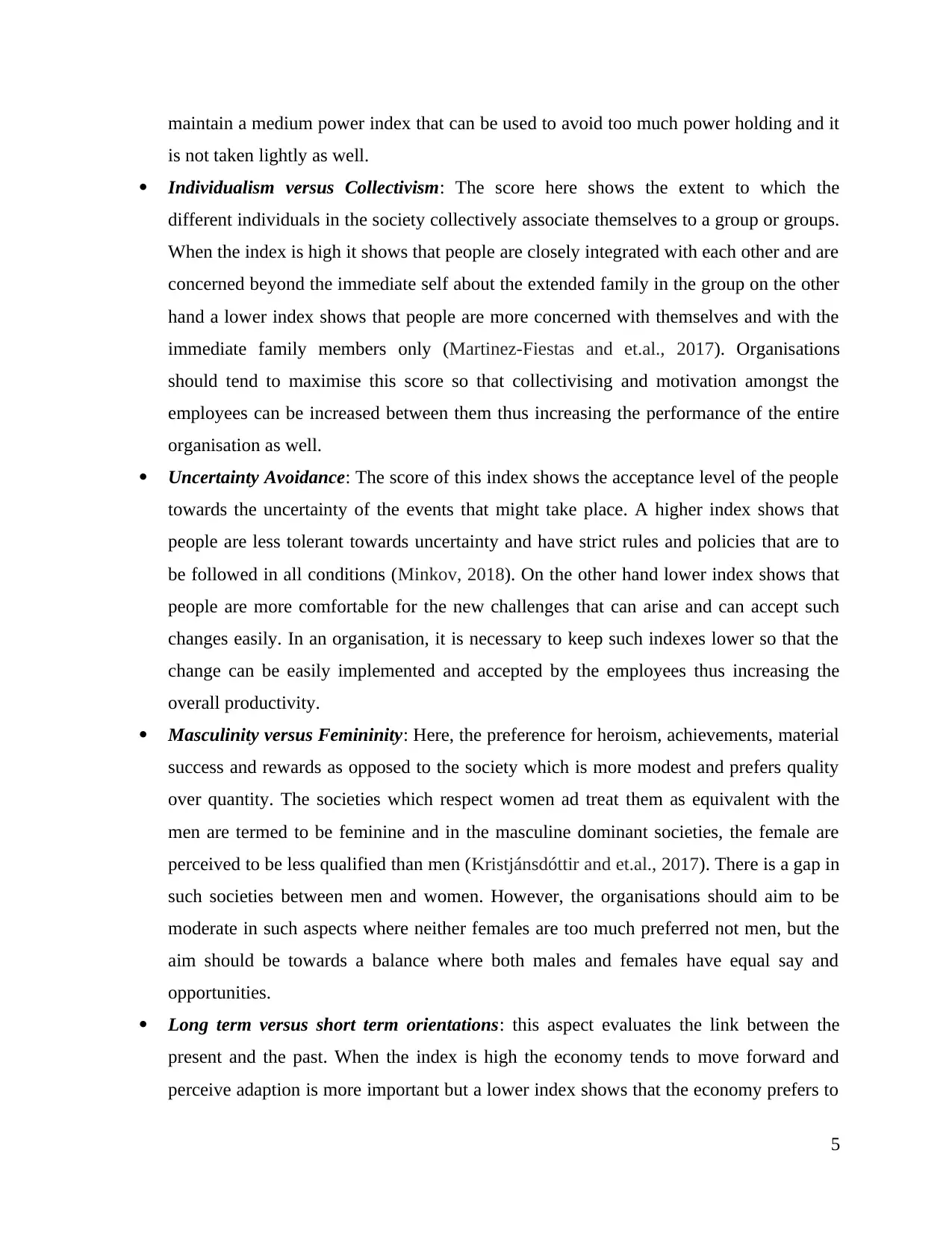
maintain a medium power index that can be used to avoid too much power holding and it
is not taken lightly as well.
Individualism versus Collectivism: The score here shows the extent to which the
different individuals in the society collectively associate themselves to a group or groups.
When the index is high it shows that people are closely integrated with each other and are
concerned beyond the immediate self about the extended family in the group on the other
hand a lower index shows that people are more concerned with themselves and with the
immediate family members only (Martinez-Fiestas and et.al., 2017). Organisations
should tend to maximise this score so that collectivising and motivation amongst the
employees can be increased between them thus increasing the performance of the entire
organisation as well.
Uncertainty Avoidance: The score of this index shows the acceptance level of the people
towards the uncertainty of the events that might take place. A higher index shows that
people are less tolerant towards uncertainty and have strict rules and policies that are to
be followed in all conditions (Minkov, 2018). On the other hand lower index shows that
people are more comfortable for the new challenges that can arise and can accept such
changes easily. In an organisation, it is necessary to keep such indexes lower so that the
change can be easily implemented and accepted by the employees thus increasing the
overall productivity.
Masculinity versus Femininity: Here, the preference for heroism, achievements, material
success and rewards as opposed to the society which is more modest and prefers quality
over quantity. The societies which respect women ad treat them as equivalent with the
men are termed to be feminine and in the masculine dominant societies, the female are
perceived to be less qualified than men (Kristjánsdóttir and et.al., 2017). There is a gap in
such societies between men and women. However, the organisations should aim to be
moderate in such aspects where neither females are too much preferred not men, but the
aim should be towards a balance where both males and females have equal say and
opportunities.
Long term versus short term orientations: this aspect evaluates the link between the
present and the past. When the index is high the economy tends to move forward and
perceive adaption is more important but a lower index shows that the economy prefers to
5
is not taken lightly as well.
Individualism versus Collectivism: The score here shows the extent to which the
different individuals in the society collectively associate themselves to a group or groups.
When the index is high it shows that people are closely integrated with each other and are
concerned beyond the immediate self about the extended family in the group on the other
hand a lower index shows that people are more concerned with themselves and with the
immediate family members only (Martinez-Fiestas and et.al., 2017). Organisations
should tend to maximise this score so that collectivising and motivation amongst the
employees can be increased between them thus increasing the performance of the entire
organisation as well.
Uncertainty Avoidance: The score of this index shows the acceptance level of the people
towards the uncertainty of the events that might take place. A higher index shows that
people are less tolerant towards uncertainty and have strict rules and policies that are to
be followed in all conditions (Minkov, 2018). On the other hand lower index shows that
people are more comfortable for the new challenges that can arise and can accept such
changes easily. In an organisation, it is necessary to keep such indexes lower so that the
change can be easily implemented and accepted by the employees thus increasing the
overall productivity.
Masculinity versus Femininity: Here, the preference for heroism, achievements, material
success and rewards as opposed to the society which is more modest and prefers quality
over quantity. The societies which respect women ad treat them as equivalent with the
men are termed to be feminine and in the masculine dominant societies, the female are
perceived to be less qualified than men (Kristjánsdóttir and et.al., 2017). There is a gap in
such societies between men and women. However, the organisations should aim to be
moderate in such aspects where neither females are too much preferred not men, but the
aim should be towards a balance where both males and females have equal say and
opportunities.
Long term versus short term orientations: this aspect evaluates the link between the
present and the past. When the index is high the economy tends to move forward and
perceive adaption is more important but a lower index shows that the economy prefers to
5
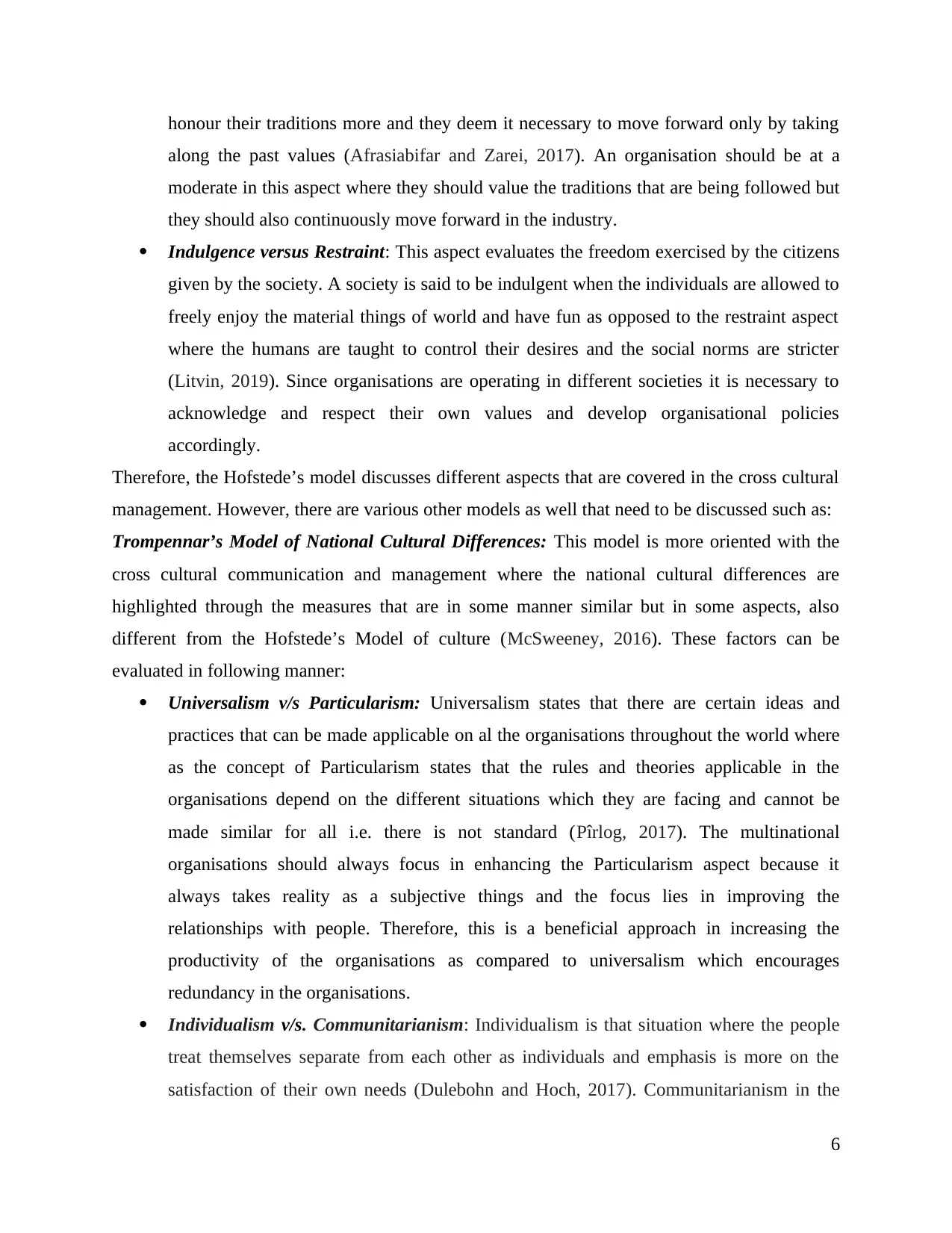
honour their traditions more and they deem it necessary to move forward only by taking
along the past values (Afrasiabifar and Zarei, 2017). An organisation should be at a
moderate in this aspect where they should value the traditions that are being followed but
they should also continuously move forward in the industry.
Indulgence versus Restraint: This aspect evaluates the freedom exercised by the citizens
given by the society. A society is said to be indulgent when the individuals are allowed to
freely enjoy the material things of world and have fun as opposed to the restraint aspect
where the humans are taught to control their desires and the social norms are stricter
(Litvin, 2019). Since organisations are operating in different societies it is necessary to
acknowledge and respect their own values and develop organisational policies
accordingly.
Therefore, the Hofstede’s model discusses different aspects that are covered in the cross cultural
management. However, there are various other models as well that need to be discussed such as:
Trompennar’s Model of National Cultural Differences: This model is more oriented with the
cross cultural communication and management where the national cultural differences are
highlighted through the measures that are in some manner similar but in some aspects, also
different from the Hofstede’s Model of culture (McSweeney, 2016). These factors can be
evaluated in following manner:
Universalism v/s Particularism: Universalism states that there are certain ideas and
practices that can be made applicable on al the organisations throughout the world where
as the concept of Particularism states that the rules and theories applicable in the
organisations depend on the different situations which they are facing and cannot be
made similar for all i.e. there is not standard (Pîrlog, 2017). The multinational
organisations should always focus in enhancing the Particularism aspect because it
always takes reality as a subjective things and the focus lies in improving the
relationships with people. Therefore, this is a beneficial approach in increasing the
productivity of the organisations as compared to universalism which encourages
redundancy in the organisations.
Individualism v/s. Communitarianism: Individualism is that situation where the people
treat themselves separate from each other as individuals and emphasis is more on the
satisfaction of their own needs (Dulebohn and Hoch, 2017). Communitarianism in the
6
along the past values (Afrasiabifar and Zarei, 2017). An organisation should be at a
moderate in this aspect where they should value the traditions that are being followed but
they should also continuously move forward in the industry.
Indulgence versus Restraint: This aspect evaluates the freedom exercised by the citizens
given by the society. A society is said to be indulgent when the individuals are allowed to
freely enjoy the material things of world and have fun as opposed to the restraint aspect
where the humans are taught to control their desires and the social norms are stricter
(Litvin, 2019). Since organisations are operating in different societies it is necessary to
acknowledge and respect their own values and develop organisational policies
accordingly.
Therefore, the Hofstede’s model discusses different aspects that are covered in the cross cultural
management. However, there are various other models as well that need to be discussed such as:
Trompennar’s Model of National Cultural Differences: This model is more oriented with the
cross cultural communication and management where the national cultural differences are
highlighted through the measures that are in some manner similar but in some aspects, also
different from the Hofstede’s Model of culture (McSweeney, 2016). These factors can be
evaluated in following manner:
Universalism v/s Particularism: Universalism states that there are certain ideas and
practices that can be made applicable on al the organisations throughout the world where
as the concept of Particularism states that the rules and theories applicable in the
organisations depend on the different situations which they are facing and cannot be
made similar for all i.e. there is not standard (Pîrlog, 2017). The multinational
organisations should always focus in enhancing the Particularism aspect because it
always takes reality as a subjective things and the focus lies in improving the
relationships with people. Therefore, this is a beneficial approach in increasing the
productivity of the organisations as compared to universalism which encourages
redundancy in the organisations.
Individualism v/s. Communitarianism: Individualism is that situation where the people
treat themselves separate from each other as individuals and emphasis is more on the
satisfaction of their own needs (Dulebohn and Hoch, 2017). Communitarianism in the
6
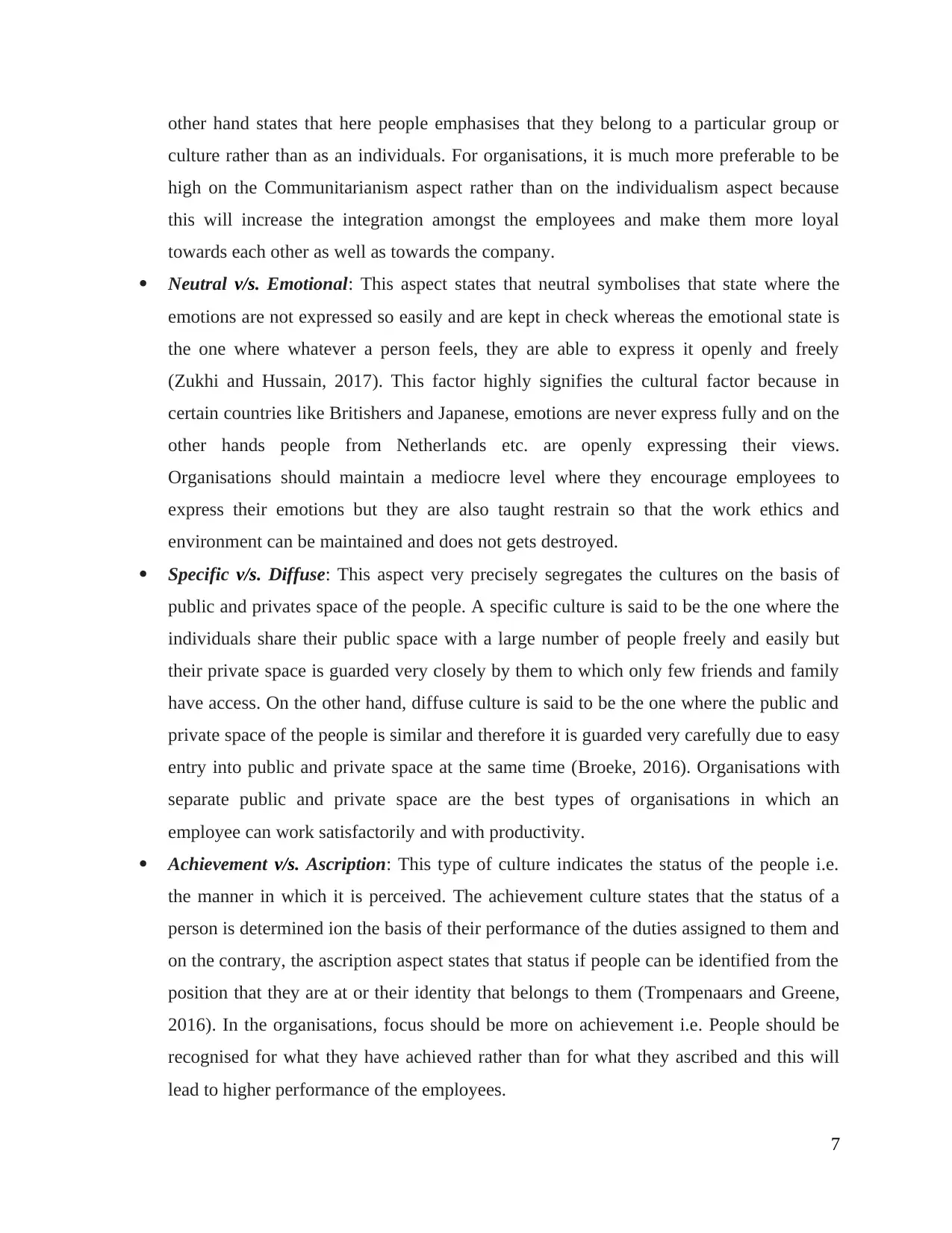
other hand states that here people emphasises that they belong to a particular group or
culture rather than as an individuals. For organisations, it is much more preferable to be
high on the Communitarianism aspect rather than on the individualism aspect because
this will increase the integration amongst the employees and make them more loyal
towards each other as well as towards the company.
Neutral v/s. Emotional: This aspect states that neutral symbolises that state where the
emotions are not expressed so easily and are kept in check whereas the emotional state is
the one where whatever a person feels, they are able to express it openly and freely
(Zukhi and Hussain, 2017). This factor highly signifies the cultural factor because in
certain countries like Britishers and Japanese, emotions are never express fully and on the
other hands people from Netherlands etc. are openly expressing their views.
Organisations should maintain a mediocre level where they encourage employees to
express their emotions but they are also taught restrain so that the work ethics and
environment can be maintained and does not gets destroyed.
Specific v/s. Diffuse: This aspect very precisely segregates the cultures on the basis of
public and privates space of the people. A specific culture is said to be the one where the
individuals share their public space with a large number of people freely and easily but
their private space is guarded very closely by them to which only few friends and family
have access. On the other hand, diffuse culture is said to be the one where the public and
private space of the people is similar and therefore it is guarded very carefully due to easy
entry into public and private space at the same time (Broeke, 2016). Organisations with
separate public and private space are the best types of organisations in which an
employee can work satisfactorily and with productivity.
Achievement v/s. Ascription: This type of culture indicates the status of the people i.e.
the manner in which it is perceived. The achievement culture states that the status of a
person is determined ion the basis of their performance of the duties assigned to them and
on the contrary, the ascription aspect states that status if people can be identified from the
position that they are at or their identity that belongs to them (Trompenaars and Greene,
2016). In the organisations, focus should be more on achievement i.e. People should be
recognised for what they have achieved rather than for what they ascribed and this will
lead to higher performance of the employees.
7
culture rather than as an individuals. For organisations, it is much more preferable to be
high on the Communitarianism aspect rather than on the individualism aspect because
this will increase the integration amongst the employees and make them more loyal
towards each other as well as towards the company.
Neutral v/s. Emotional: This aspect states that neutral symbolises that state where the
emotions are not expressed so easily and are kept in check whereas the emotional state is
the one where whatever a person feels, they are able to express it openly and freely
(Zukhi and Hussain, 2017). This factor highly signifies the cultural factor because in
certain countries like Britishers and Japanese, emotions are never express fully and on the
other hands people from Netherlands etc. are openly expressing their views.
Organisations should maintain a mediocre level where they encourage employees to
express their emotions but they are also taught restrain so that the work ethics and
environment can be maintained and does not gets destroyed.
Specific v/s. Diffuse: This aspect very precisely segregates the cultures on the basis of
public and privates space of the people. A specific culture is said to be the one where the
individuals share their public space with a large number of people freely and easily but
their private space is guarded very closely by them to which only few friends and family
have access. On the other hand, diffuse culture is said to be the one where the public and
private space of the people is similar and therefore it is guarded very carefully due to easy
entry into public and private space at the same time (Broeke, 2016). Organisations with
separate public and private space are the best types of organisations in which an
employee can work satisfactorily and with productivity.
Achievement v/s. Ascription: This type of culture indicates the status of the people i.e.
the manner in which it is perceived. The achievement culture states that the status of a
person is determined ion the basis of their performance of the duties assigned to them and
on the contrary, the ascription aspect states that status if people can be identified from the
position that they are at or their identity that belongs to them (Trompenaars and Greene,
2016). In the organisations, focus should be more on achievement i.e. People should be
recognised for what they have achieved rather than for what they ascribed and this will
lead to higher performance of the employees.
7
Paraphrase This Document
Need a fresh take? Get an instant paraphrase of this document with our AI Paraphraser
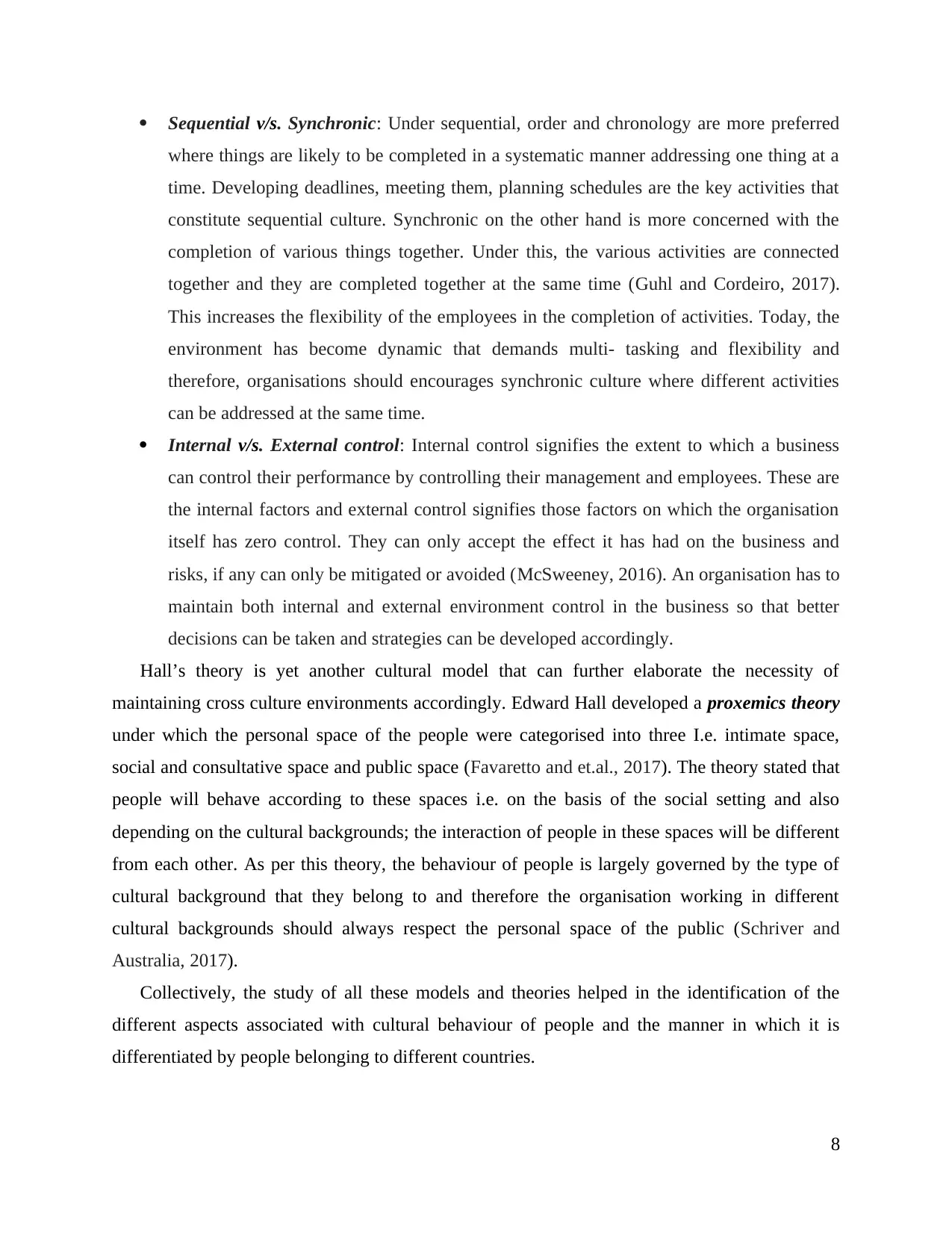
Sequential v/s. Synchronic: Under sequential, order and chronology are more preferred
where things are likely to be completed in a systematic manner addressing one thing at a
time. Developing deadlines, meeting them, planning schedules are the key activities that
constitute sequential culture. Synchronic on the other hand is more concerned with the
completion of various things together. Under this, the various activities are connected
together and they are completed together at the same time (Guhl and Cordeiro, 2017).
This increases the flexibility of the employees in the completion of activities. Today, the
environment has become dynamic that demands multi- tasking and flexibility and
therefore, organisations should encourages synchronic culture where different activities
can be addressed at the same time.
Internal v/s. External control: Internal control signifies the extent to which a business
can control their performance by controlling their management and employees. These are
the internal factors and external control signifies those factors on which the organisation
itself has zero control. They can only accept the effect it has had on the business and
risks, if any can only be mitigated or avoided (McSweeney, 2016). An organisation has to
maintain both internal and external environment control in the business so that better
decisions can be taken and strategies can be developed accordingly.
Hall’s theory is yet another cultural model that can further elaborate the necessity of
maintaining cross culture environments accordingly. Edward Hall developed a proxemics theory
under which the personal space of the people were categorised into three I.e. intimate space,
social and consultative space and public space (Favaretto and et.al., 2017). The theory stated that
people will behave according to these spaces i.e. on the basis of the social setting and also
depending on the cultural backgrounds; the interaction of people in these spaces will be different
from each other. As per this theory, the behaviour of people is largely governed by the type of
cultural background that they belong to and therefore the organisation working in different
cultural backgrounds should always respect the personal space of the public (Schriver and
Australia, 2017).
Collectively, the study of all these models and theories helped in the identification of the
different aspects associated with cultural behaviour of people and the manner in which it is
differentiated by people belonging to different countries.
8
where things are likely to be completed in a systematic manner addressing one thing at a
time. Developing deadlines, meeting them, planning schedules are the key activities that
constitute sequential culture. Synchronic on the other hand is more concerned with the
completion of various things together. Under this, the various activities are connected
together and they are completed together at the same time (Guhl and Cordeiro, 2017).
This increases the flexibility of the employees in the completion of activities. Today, the
environment has become dynamic that demands multi- tasking and flexibility and
therefore, organisations should encourages synchronic culture where different activities
can be addressed at the same time.
Internal v/s. External control: Internal control signifies the extent to which a business
can control their performance by controlling their management and employees. These are
the internal factors and external control signifies those factors on which the organisation
itself has zero control. They can only accept the effect it has had on the business and
risks, if any can only be mitigated or avoided (McSweeney, 2016). An organisation has to
maintain both internal and external environment control in the business so that better
decisions can be taken and strategies can be developed accordingly.
Hall’s theory is yet another cultural model that can further elaborate the necessity of
maintaining cross culture environments accordingly. Edward Hall developed a proxemics theory
under which the personal space of the people were categorised into three I.e. intimate space,
social and consultative space and public space (Favaretto and et.al., 2017). The theory stated that
people will behave according to these spaces i.e. on the basis of the social setting and also
depending on the cultural backgrounds; the interaction of people in these spaces will be different
from each other. As per this theory, the behaviour of people is largely governed by the type of
cultural background that they belong to and therefore the organisation working in different
cultural backgrounds should always respect the personal space of the public (Schriver and
Australia, 2017).
Collectively, the study of all these models and theories helped in the identification of the
different aspects associated with cultural behaviour of people and the manner in which it is
differentiated by people belonging to different countries.
8
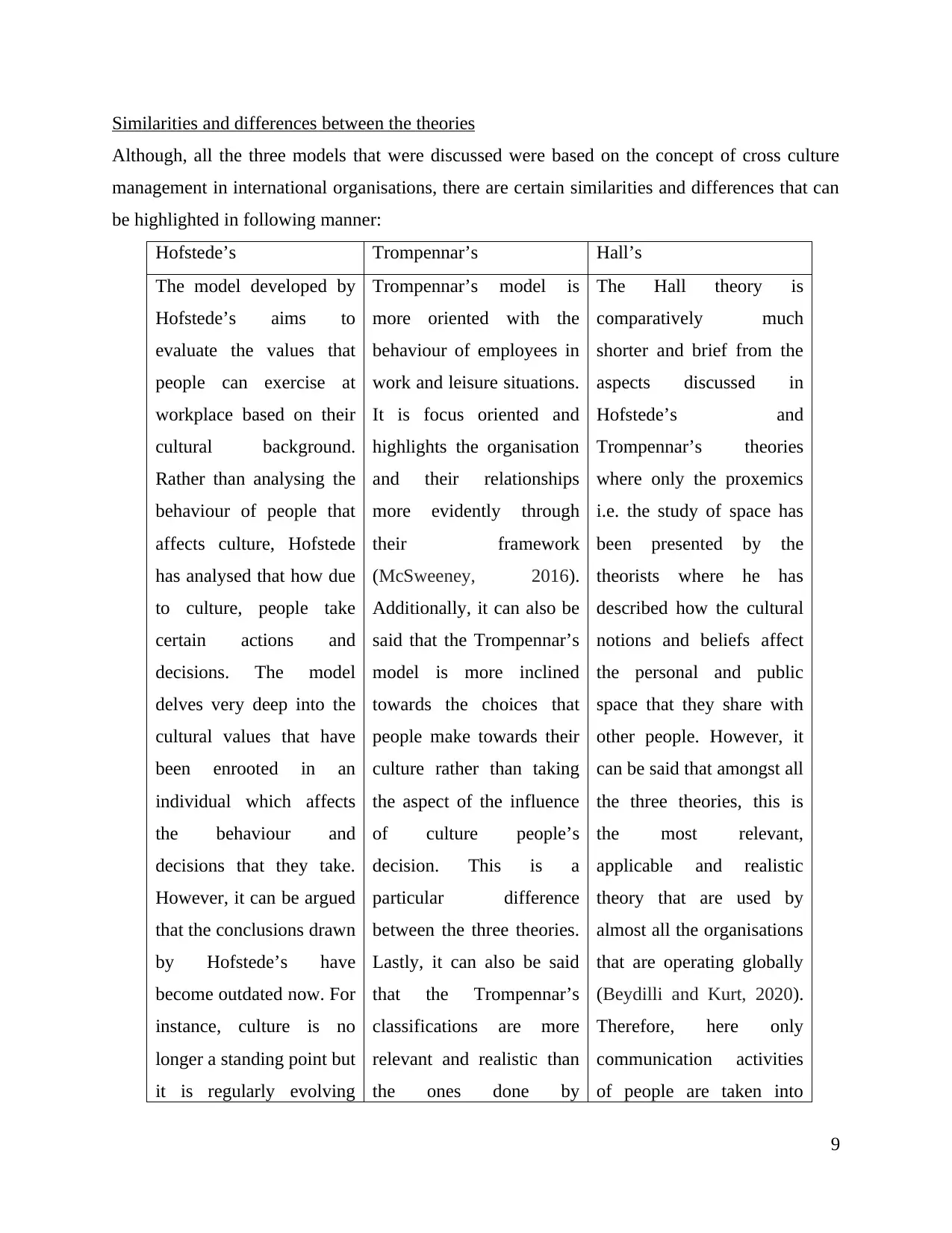
Similarities and differences between the theories
Although, all the three models that were discussed were based on the concept of cross culture
management in international organisations, there are certain similarities and differences that can
be highlighted in following manner:
Hofstede’s Trompennar’s Hall’s
The model developed by
Hofstede’s aims to
evaluate the values that
people can exercise at
workplace based on their
cultural background.
Rather than analysing the
behaviour of people that
affects culture, Hofstede
has analysed that how due
to culture, people take
certain actions and
decisions. The model
delves very deep into the
cultural values that have
been enrooted in an
individual which affects
the behaviour and
decisions that they take.
However, it can be argued
that the conclusions drawn
by Hofstede’s have
become outdated now. For
instance, culture is no
longer a standing point but
it is regularly evolving
Trompennar’s model is
more oriented with the
behaviour of employees in
work and leisure situations.
It is focus oriented and
highlights the organisation
and their relationships
more evidently through
their framework
(McSweeney, 2016).
Additionally, it can also be
said that the Trompennar’s
model is more inclined
towards the choices that
people make towards their
culture rather than taking
the aspect of the influence
of culture people’s
decision. This is a
particular difference
between the three theories.
Lastly, it can also be said
that the Trompennar’s
classifications are more
relevant and realistic than
the ones done by
The Hall theory is
comparatively much
shorter and brief from the
aspects discussed in
Hofstede’s and
Trompennar’s theories
where only the proxemics
i.e. the study of space has
been presented by the
theorists where he has
described how the cultural
notions and beliefs affect
the personal and public
space that they share with
other people. However, it
can be said that amongst all
the three theories, this is
the most relevant,
applicable and realistic
theory that are used by
almost all the organisations
that are operating globally
(Beydilli and Kurt, 2020).
Therefore, here only
communication activities
of people are taken into
9
Although, all the three models that were discussed were based on the concept of cross culture
management in international organisations, there are certain similarities and differences that can
be highlighted in following manner:
Hofstede’s Trompennar’s Hall’s
The model developed by
Hofstede’s aims to
evaluate the values that
people can exercise at
workplace based on their
cultural background.
Rather than analysing the
behaviour of people that
affects culture, Hofstede
has analysed that how due
to culture, people take
certain actions and
decisions. The model
delves very deep into the
cultural values that have
been enrooted in an
individual which affects
the behaviour and
decisions that they take.
However, it can be argued
that the conclusions drawn
by Hofstede’s have
become outdated now. For
instance, culture is no
longer a standing point but
it is regularly evolving
Trompennar’s model is
more oriented with the
behaviour of employees in
work and leisure situations.
It is focus oriented and
highlights the organisation
and their relationships
more evidently through
their framework
(McSweeney, 2016).
Additionally, it can also be
said that the Trompennar’s
model is more inclined
towards the choices that
people make towards their
culture rather than taking
the aspect of the influence
of culture people’s
decision. This is a
particular difference
between the three theories.
Lastly, it can also be said
that the Trompennar’s
classifications are more
relevant and realistic than
the ones done by
The Hall theory is
comparatively much
shorter and brief from the
aspects discussed in
Hofstede’s and
Trompennar’s theories
where only the proxemics
i.e. the study of space has
been presented by the
theorists where he has
described how the cultural
notions and beliefs affect
the personal and public
space that they share with
other people. However, it
can be said that amongst all
the three theories, this is
the most relevant,
applicable and realistic
theory that are used by
almost all the organisations
that are operating globally
(Beydilli and Kurt, 2020).
Therefore, here only
communication activities
of people are taken into
9
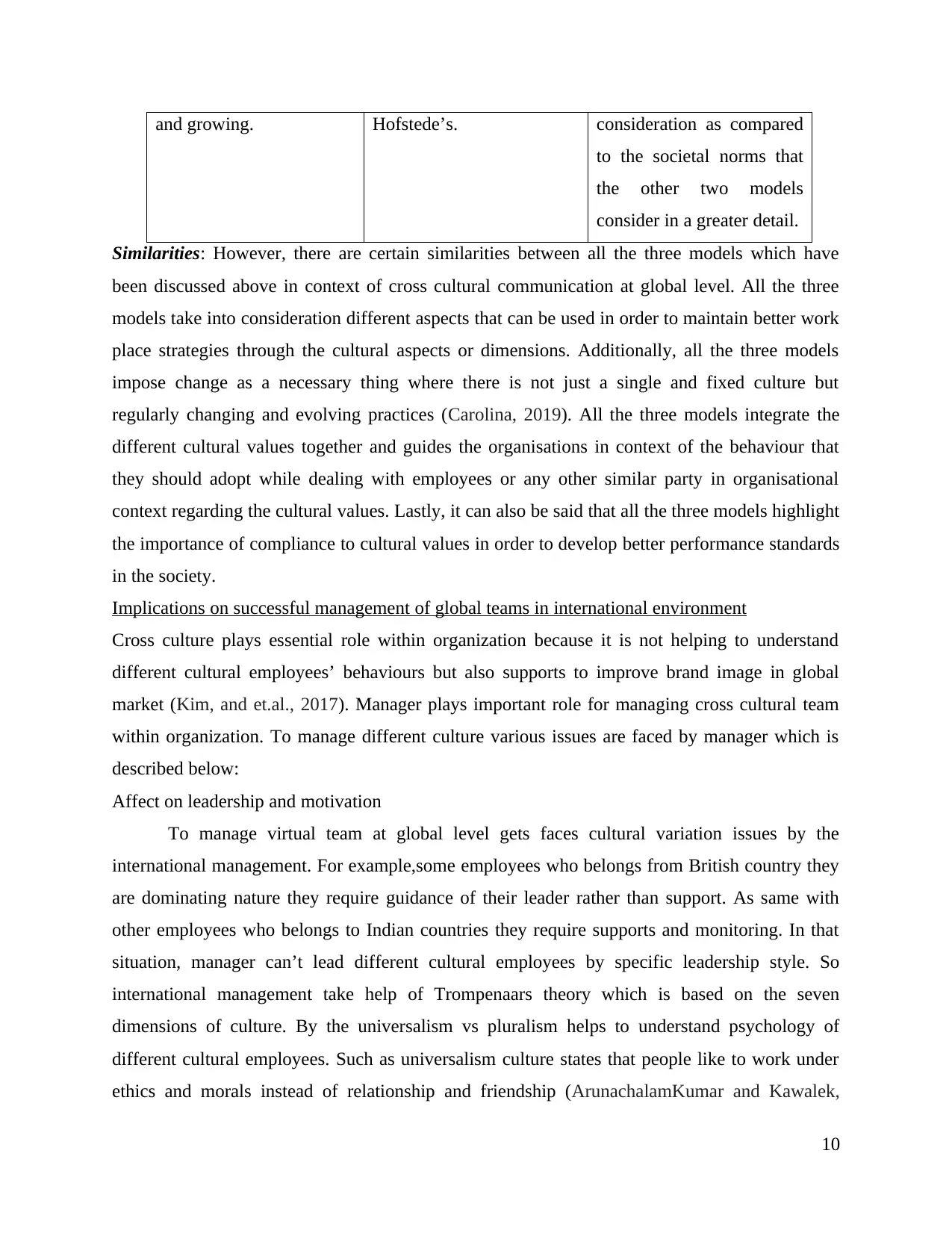
and growing. Hofstede’s. consideration as compared
to the societal norms that
the other two models
consider in a greater detail.
Similarities: However, there are certain similarities between all the three models which have
been discussed above in context of cross cultural communication at global level. All the three
models take into consideration different aspects that can be used in order to maintain better work
place strategies through the cultural aspects or dimensions. Additionally, all the three models
impose change as a necessary thing where there is not just a single and fixed culture but
regularly changing and evolving practices (Carolina, 2019). All the three models integrate the
different cultural values together and guides the organisations in context of the behaviour that
they should adopt while dealing with employees or any other similar party in organisational
context regarding the cultural values. Lastly, it can also be said that all the three models highlight
the importance of compliance to cultural values in order to develop better performance standards
in the society.
Implications on successful management of global teams in international environment
Cross culture plays essential role within organization because it is not helping to understand
different cultural employees’ behaviours but also supports to improve brand image in global
market (Kim, and et.al., 2017). Manager plays important role for managing cross cultural team
within organization. To manage different culture various issues are faced by manager which is
described below:
Affect on leadership and motivation
To manage virtual team at global level gets faces cultural variation issues by the
international management. For example,some employees who belongs from British country they
are dominating nature they require guidance of their leader rather than support. As same with
other employees who belongs to Indian countries they require supports and monitoring. In that
situation, manager can’t lead different cultural employees by specific leadership style. So
international management take help of Trompenaars theory which is based on the seven
dimensions of culture. By the universalism vs pluralism helps to understand psychology of
different cultural employees. Such as universalism culture states that people like to work under
ethics and morals instead of relationship and friendship (ArunachalamKumar and Kawalek,
10
to the societal norms that
the other two models
consider in a greater detail.
Similarities: However, there are certain similarities between all the three models which have
been discussed above in context of cross cultural communication at global level. All the three
models take into consideration different aspects that can be used in order to maintain better work
place strategies through the cultural aspects or dimensions. Additionally, all the three models
impose change as a necessary thing where there is not just a single and fixed culture but
regularly changing and evolving practices (Carolina, 2019). All the three models integrate the
different cultural values together and guides the organisations in context of the behaviour that
they should adopt while dealing with employees or any other similar party in organisational
context regarding the cultural values. Lastly, it can also be said that all the three models highlight
the importance of compliance to cultural values in order to develop better performance standards
in the society.
Implications on successful management of global teams in international environment
Cross culture plays essential role within organization because it is not helping to understand
different cultural employees’ behaviours but also supports to improve brand image in global
market (Kim, and et.al., 2017). Manager plays important role for managing cross cultural team
within organization. To manage different culture various issues are faced by manager which is
described below:
Affect on leadership and motivation
To manage virtual team at global level gets faces cultural variation issues by the
international management. For example,some employees who belongs from British country they
are dominating nature they require guidance of their leader rather than support. As same with
other employees who belongs to Indian countries they require supports and monitoring. In that
situation, manager can’t lead different cultural employees by specific leadership style. So
international management take help of Trompenaars theory which is based on the seven
dimensions of culture. By the universalism vs pluralism helps to understand psychology of
different cultural employees. Such as universalism culture states that people like to work under
ethics and morals instead of relationship and friendship (ArunachalamKumar and Kawalek,
10
Secure Best Marks with AI Grader
Need help grading? Try our AI Grader for instant feedback on your assignments.
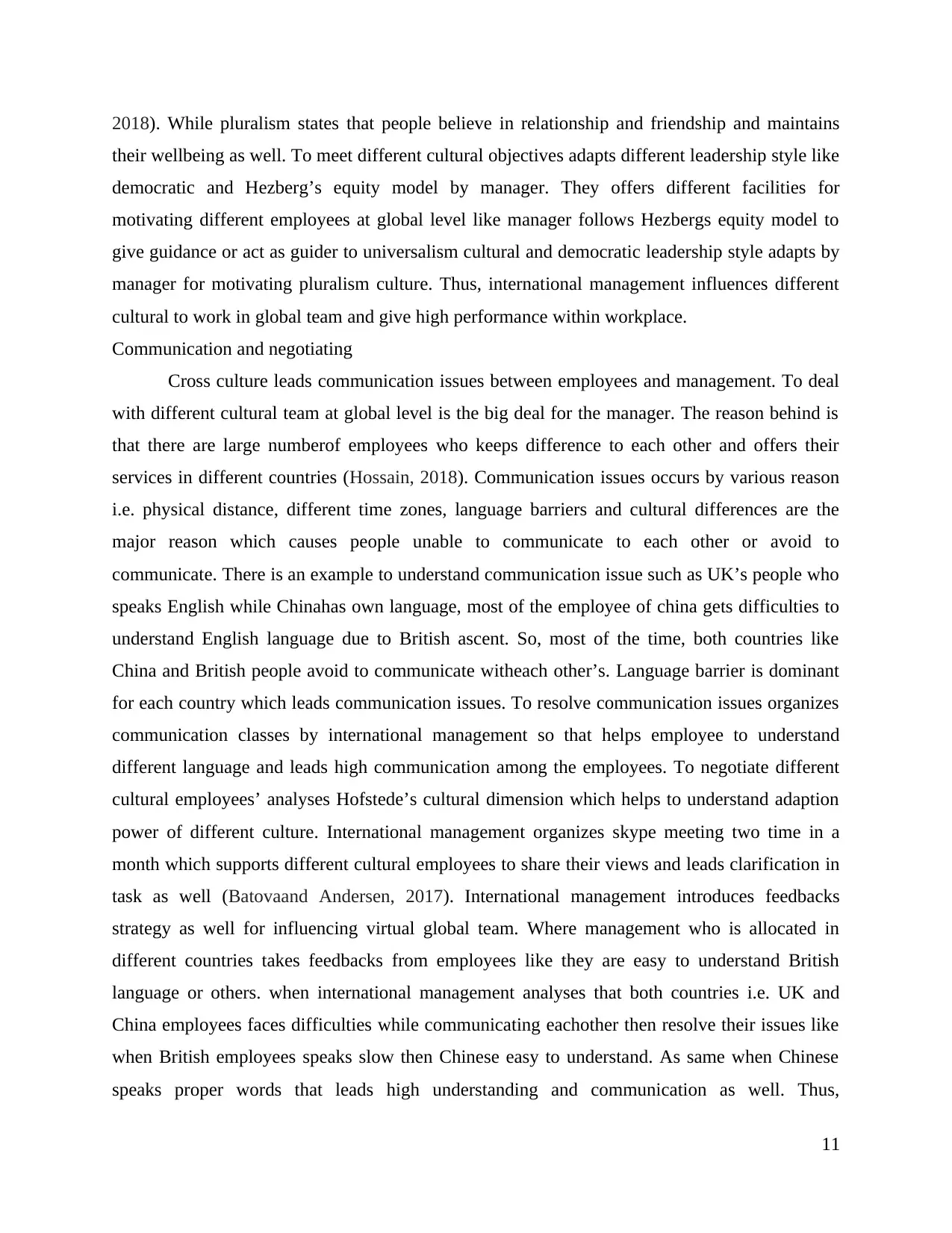
2018). While pluralism states that people believe in relationship and friendship and maintains
their wellbeing as well. To meet different cultural objectives adapts different leadership style like
democratic and Hezberg’s equity model by manager. They offers different facilities for
motivating different employees at global level like manager follows Hezbergs equity model to
give guidance or act as guider to universalism cultural and democratic leadership style adapts by
manager for motivating pluralism culture. Thus, international management influences different
cultural to work in global team and give high performance within workplace.
Communication and negotiating
Cross culture leads communication issues between employees and management. To deal
with different cultural team at global level is the big deal for the manager. The reason behind is
that there are large numberof employees who keeps difference to each other and offers their
services in different countries (Hossain, 2018). Communication issues occurs by various reason
i.e. physical distance, different time zones, language barriers and cultural differences are the
major reason which causes people unable to communicate to each other or avoid to
communicate. There is an example to understand communication issue such as UK’s people who
speaks English while Chinahas own language, most of the employee of china gets difficulties to
understand English language due to British ascent. So, most of the time, both countries like
China and British people avoid to communicate witheach other’s. Language barrier is dominant
for each country which leads communication issues. To resolve communication issues organizes
communication classes by international management so that helps employee to understand
different language and leads high communication among the employees. To negotiate different
cultural employees’ analyses Hofstede’s cultural dimension which helps to understand adaption
power of different culture. International management organizes skype meeting two time in a
month which supports different cultural employees to share their views and leads clarification in
task as well (Batovaand Andersen, 2017). International management introduces feedbacks
strategy as well for influencing virtual global team. Where management who is allocated in
different countries takes feedbacks from employees like they are easy to understand British
language or others. when international management analyses that both countries i.e. UK and
China employees faces difficulties while communicating eachother then resolve their issues like
when British employees speaks slow then Chinese easy to understand. As same when Chinese
speaks proper words that leads high understanding and communication as well. Thus,
11
their wellbeing as well. To meet different cultural objectives adapts different leadership style like
democratic and Hezberg’s equity model by manager. They offers different facilities for
motivating different employees at global level like manager follows Hezbergs equity model to
give guidance or act as guider to universalism cultural and democratic leadership style adapts by
manager for motivating pluralism culture. Thus, international management influences different
cultural to work in global team and give high performance within workplace.
Communication and negotiating
Cross culture leads communication issues between employees and management. To deal
with different cultural team at global level is the big deal for the manager. The reason behind is
that there are large numberof employees who keeps difference to each other and offers their
services in different countries (Hossain, 2018). Communication issues occurs by various reason
i.e. physical distance, different time zones, language barriers and cultural differences are the
major reason which causes people unable to communicate to each other or avoid to
communicate. There is an example to understand communication issue such as UK’s people who
speaks English while Chinahas own language, most of the employee of china gets difficulties to
understand English language due to British ascent. So, most of the time, both countries like
China and British people avoid to communicate witheach other’s. Language barrier is dominant
for each country which leads communication issues. To resolve communication issues organizes
communication classes by international management so that helps employee to understand
different language and leads high communication among the employees. To negotiate different
cultural employees’ analyses Hofstede’s cultural dimension which helps to understand adaption
power of different culture. International management organizes skype meeting two time in a
month which supports different cultural employees to share their views and leads clarification in
task as well (Batovaand Andersen, 2017). International management introduces feedbacks
strategy as well for influencing virtual global team. Where management who is allocated in
different countries takes feedbacks from employees like they are easy to understand British
language or others. when international management analyses that both countries i.e. UK and
China employees faces difficulties while communicating eachother then resolve their issues like
when British employees speaks slow then Chinese easy to understand. As same when Chinese
speaks proper words that leads high understanding and communication as well. Thus,
11
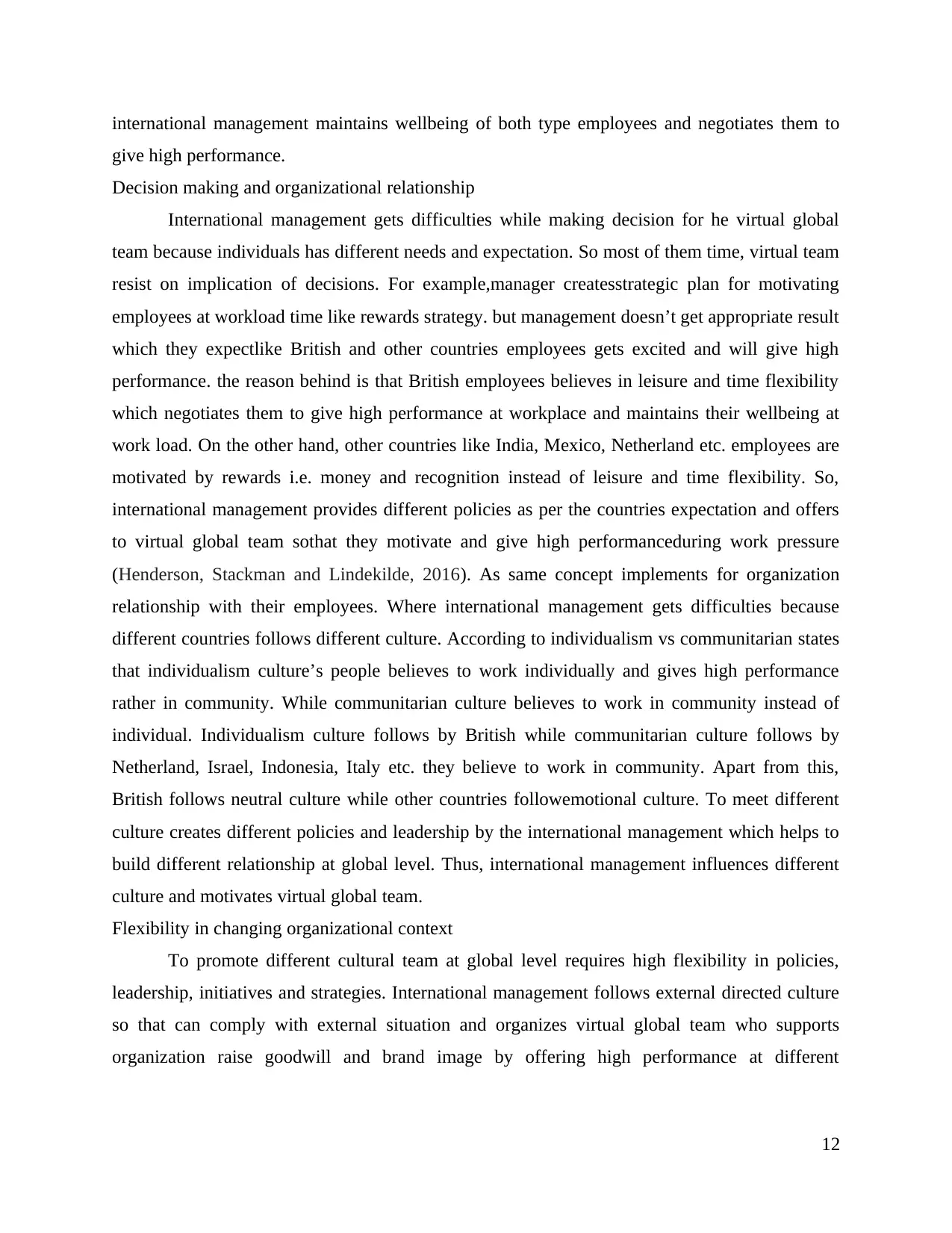
international management maintains wellbeing of both type employees and negotiates them to
give high performance.
Decision making and organizational relationship
International management gets difficulties while making decision for he virtual global
team because individuals has different needs and expectation. So most of them time, virtual team
resist on implication of decisions. For example,manager createsstrategic plan for motivating
employees at workload time like rewards strategy. but management doesn’t get appropriate result
which they expectlike British and other countries employees gets excited and will give high
performance. the reason behind is that British employees believes in leisure and time flexibility
which negotiates them to give high performance at workplace and maintains their wellbeing at
work load. On the other hand, other countries like India, Mexico, Netherland etc. employees are
motivated by rewards i.e. money and recognition instead of leisure and time flexibility. So,
international management provides different policies as per the countries expectation and offers
to virtual global team sothat they motivate and give high performanceduring work pressure
(Henderson, Stackman and Lindekilde, 2016). As same concept implements for organization
relationship with their employees. Where international management gets difficulties because
different countries follows different culture. According to individualism vs communitarian states
that individualism culture’s people believes to work individually and gives high performance
rather in community. While communitarian culture believes to work in community instead of
individual. Individualism culture follows by British while communitarian culture follows by
Netherland, Israel, Indonesia, Italy etc. they believe to work in community. Apart from this,
British follows neutral culture while other countries followemotional culture. To meet different
culture creates different policies and leadership by the international management which helps to
build different relationship at global level. Thus, international management influences different
culture and motivates virtual global team.
Flexibility in changing organizational context
To promote different cultural team at global level requires high flexibility in policies,
leadership, initiatives and strategies. International management follows external directed culture
so that can comply with external situation and organizes virtual global team who supports
organization raise goodwill and brand image by offering high performance at different
12
give high performance.
Decision making and organizational relationship
International management gets difficulties while making decision for he virtual global
team because individuals has different needs and expectation. So most of them time, virtual team
resist on implication of decisions. For example,manager createsstrategic plan for motivating
employees at workload time like rewards strategy. but management doesn’t get appropriate result
which they expectlike British and other countries employees gets excited and will give high
performance. the reason behind is that British employees believes in leisure and time flexibility
which negotiates them to give high performance at workplace and maintains their wellbeing at
work load. On the other hand, other countries like India, Mexico, Netherland etc. employees are
motivated by rewards i.e. money and recognition instead of leisure and time flexibility. So,
international management provides different policies as per the countries expectation and offers
to virtual global team sothat they motivate and give high performanceduring work pressure
(Henderson, Stackman and Lindekilde, 2016). As same concept implements for organization
relationship with their employees. Where international management gets difficulties because
different countries follows different culture. According to individualism vs communitarian states
that individualism culture’s people believes to work individually and gives high performance
rather in community. While communitarian culture believes to work in community instead of
individual. Individualism culture follows by British while communitarian culture follows by
Netherland, Israel, Indonesia, Italy etc. they believe to work in community. Apart from this,
British follows neutral culture while other countries followemotional culture. To meet different
culture creates different policies and leadership by the international management which helps to
build different relationship at global level. Thus, international management influences different
culture and motivates virtual global team.
Flexibility in changing organizational context
To promote different cultural team at global level requires high flexibility in policies,
leadership, initiatives and strategies. International management follows external directed culture
so that can comply with external situation and organizes virtual global team who supports
organization raise goodwill and brand image by offering high performance at different
12
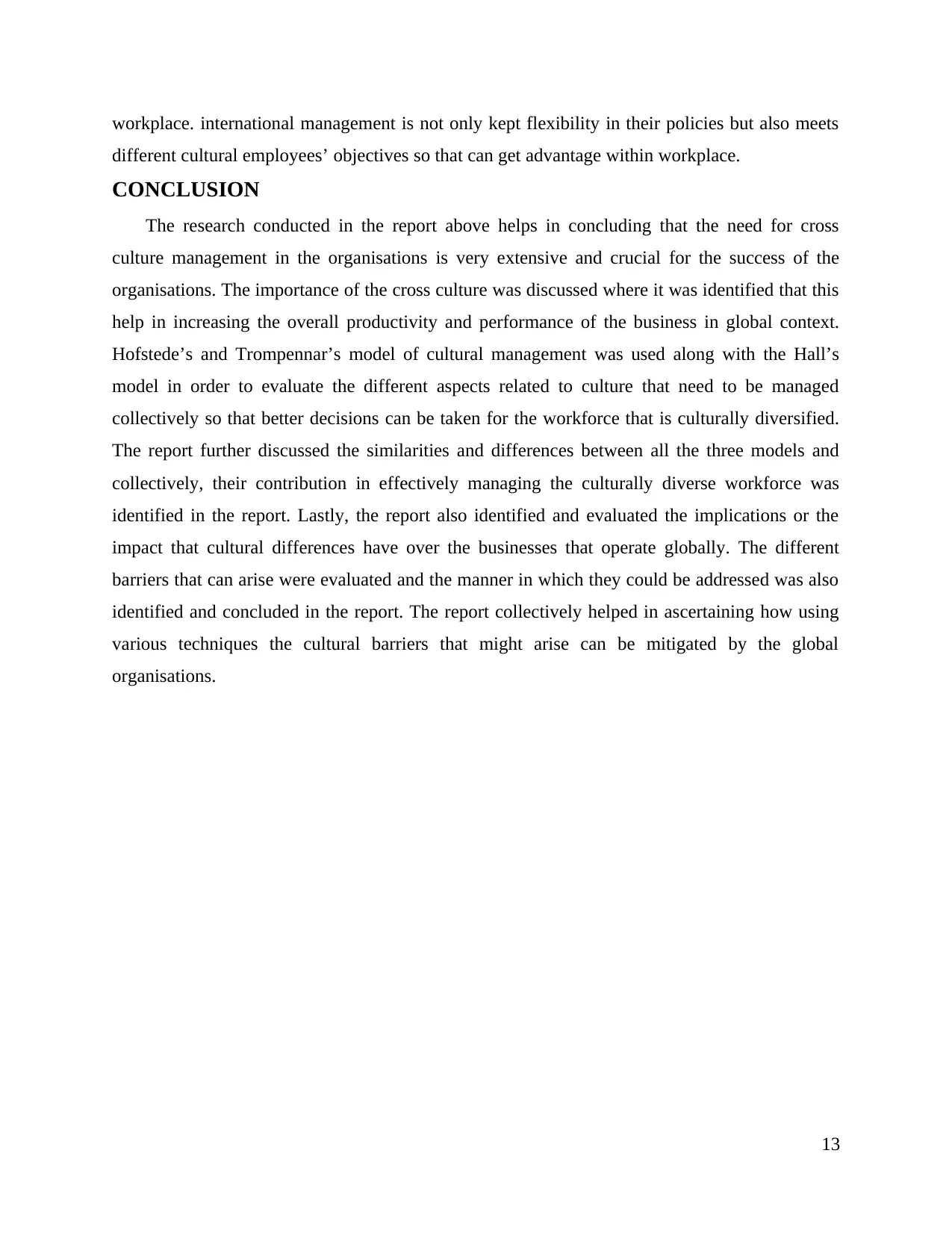
workplace. international management is not only kept flexibility in their policies but also meets
different cultural employees’ objectives so that can get advantage within workplace.
CONCLUSION
The research conducted in the report above helps in concluding that the need for cross
culture management in the organisations is very extensive and crucial for the success of the
organisations. The importance of the cross culture was discussed where it was identified that this
help in increasing the overall productivity and performance of the business in global context.
Hofstede’s and Trompennar’s model of cultural management was used along with the Hall’s
model in order to evaluate the different aspects related to culture that need to be managed
collectively so that better decisions can be taken for the workforce that is culturally diversified.
The report further discussed the similarities and differences between all the three models and
collectively, their contribution in effectively managing the culturally diverse workforce was
identified in the report. Lastly, the report also identified and evaluated the implications or the
impact that cultural differences have over the businesses that operate globally. The different
barriers that can arise were evaluated and the manner in which they could be addressed was also
identified and concluded in the report. The report collectively helped in ascertaining how using
various techniques the cultural barriers that might arise can be mitigated by the global
organisations.
13
different cultural employees’ objectives so that can get advantage within workplace.
CONCLUSION
The research conducted in the report above helps in concluding that the need for cross
culture management in the organisations is very extensive and crucial for the success of the
organisations. The importance of the cross culture was discussed where it was identified that this
help in increasing the overall productivity and performance of the business in global context.
Hofstede’s and Trompennar’s model of cultural management was used along with the Hall’s
model in order to evaluate the different aspects related to culture that need to be managed
collectively so that better decisions can be taken for the workforce that is culturally diversified.
The report further discussed the similarities and differences between all the three models and
collectively, their contribution in effectively managing the culturally diverse workforce was
identified in the report. Lastly, the report also identified and evaluated the implications or the
impact that cultural differences have over the businesses that operate globally. The different
barriers that can arise were evaluated and the manner in which they could be addressed was also
identified and concluded in the report. The report collectively helped in ascertaining how using
various techniques the cultural barriers that might arise can be mitigated by the global
organisations.
13
Paraphrase This Document
Need a fresh take? Get an instant paraphrase of this document with our AI Paraphraser
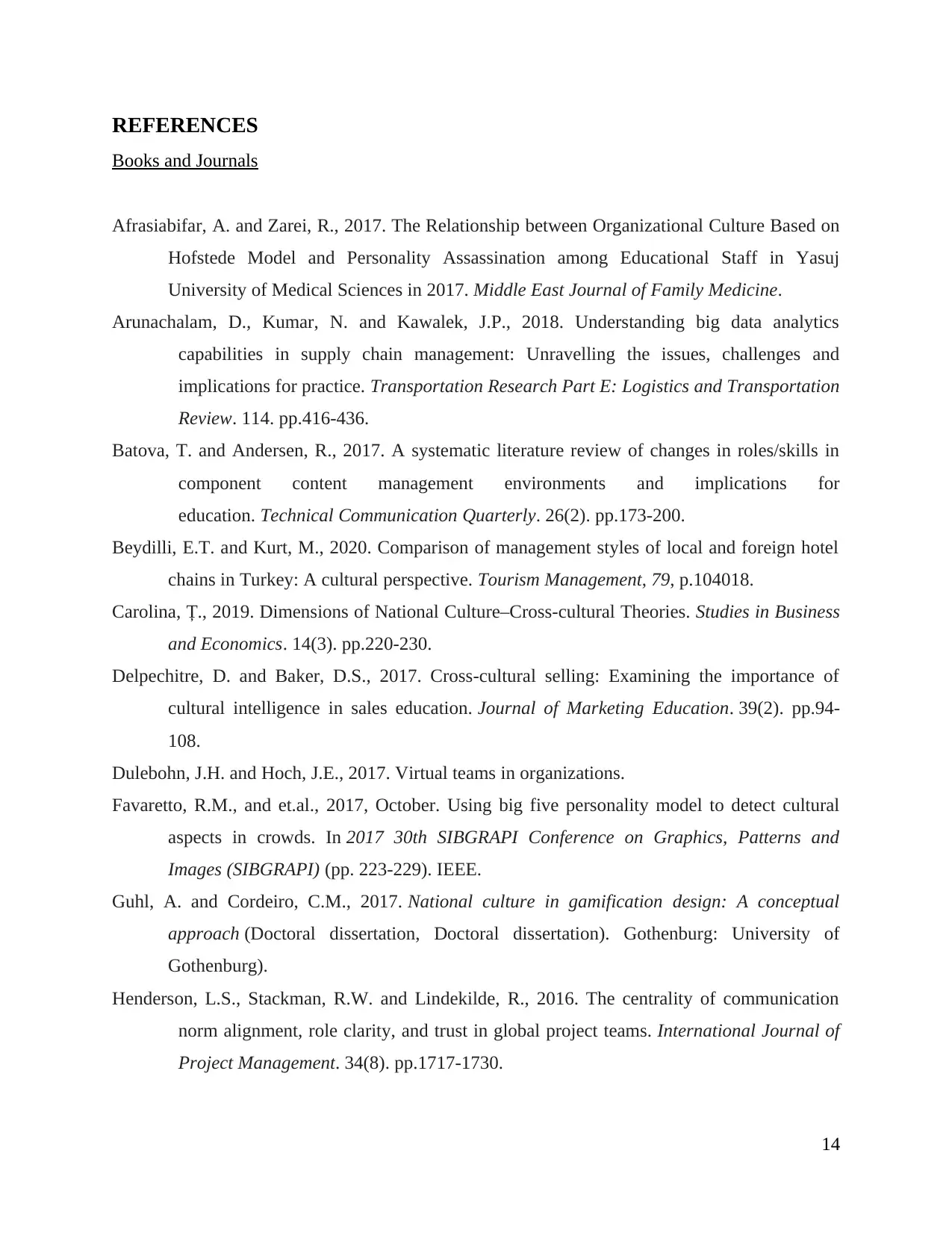
REFERENCES
Books and Journals
Afrasiabifar, A. and Zarei, R., 2017. The Relationship between Organizational Culture Based on
Hofstede Model and Personality Assassination among Educational Staff in Yasuj
University of Medical Sciences in 2017. Middle East Journal of Family Medicine.
Arunachalam, D., Kumar, N. and Kawalek, J.P., 2018. Understanding big data analytics
capabilities in supply chain management: Unravelling the issues, challenges and
implications for practice. Transportation Research Part E: Logistics and Transportation
Review. 114. pp.416-436.
Batova, T. and Andersen, R., 2017. A systematic literature review of changes in roles/skills in
component content management environments and implications for
education. Technical Communication Quarterly. 26(2). pp.173-200.
Beydilli, E.T. and Kurt, M., 2020. Comparison of management styles of local and foreign hotel
chains in Turkey: A cultural perspective. Tourism Management, 79, p.104018.
Carolina, Ț., 2019. Dimensions of National Culture–Cross-cultural Theories. Studies in Business
and Economics. 14(3). pp.220-230.
Delpechitre, D. and Baker, D.S., 2017. Cross-cultural selling: Examining the importance of
cultural intelligence in sales education. Journal of Marketing Education. 39(2). pp.94-
108.
Dulebohn, J.H. and Hoch, J.E., 2017. Virtual teams in organizations.
Favaretto, R.M., and et.al., 2017, October. Using big five personality model to detect cultural
aspects in crowds. In 2017 30th SIBGRAPI Conference on Graphics, Patterns and
Images (SIBGRAPI) (pp. 223-229). IEEE.
Guhl, A. and Cordeiro, C.M., 2017. National culture in gamification design: A conceptual
approach (Doctoral dissertation, Doctoral dissertation). Gothenburg: University of
Gothenburg).
Henderson, L.S., Stackman, R.W. and Lindekilde, R., 2016. The centrality of communication
norm alignment, role clarity, and trust in global project teams. International Journal of
Project Management. 34(8). pp.1717-1730.
14
Books and Journals
Afrasiabifar, A. and Zarei, R., 2017. The Relationship between Organizational Culture Based on
Hofstede Model and Personality Assassination among Educational Staff in Yasuj
University of Medical Sciences in 2017. Middle East Journal of Family Medicine.
Arunachalam, D., Kumar, N. and Kawalek, J.P., 2018. Understanding big data analytics
capabilities in supply chain management: Unravelling the issues, challenges and
implications for practice. Transportation Research Part E: Logistics and Transportation
Review. 114. pp.416-436.
Batova, T. and Andersen, R., 2017. A systematic literature review of changes in roles/skills in
component content management environments and implications for
education. Technical Communication Quarterly. 26(2). pp.173-200.
Beydilli, E.T. and Kurt, M., 2020. Comparison of management styles of local and foreign hotel
chains in Turkey: A cultural perspective. Tourism Management, 79, p.104018.
Carolina, Ț., 2019. Dimensions of National Culture–Cross-cultural Theories. Studies in Business
and Economics. 14(3). pp.220-230.
Delpechitre, D. and Baker, D.S., 2017. Cross-cultural selling: Examining the importance of
cultural intelligence in sales education. Journal of Marketing Education. 39(2). pp.94-
108.
Dulebohn, J.H. and Hoch, J.E., 2017. Virtual teams in organizations.
Favaretto, R.M., and et.al., 2017, October. Using big five personality model to detect cultural
aspects in crowds. In 2017 30th SIBGRAPI Conference on Graphics, Patterns and
Images (SIBGRAPI) (pp. 223-229). IEEE.
Guhl, A. and Cordeiro, C.M., 2017. National culture in gamification design: A conceptual
approach (Doctoral dissertation, Doctoral dissertation). Gothenburg: University of
Gothenburg).
Henderson, L.S., Stackman, R.W. and Lindekilde, R., 2016. The centrality of communication
norm alignment, role clarity, and trust in global project teams. International Journal of
Project Management. 34(8). pp.1717-1730.
14
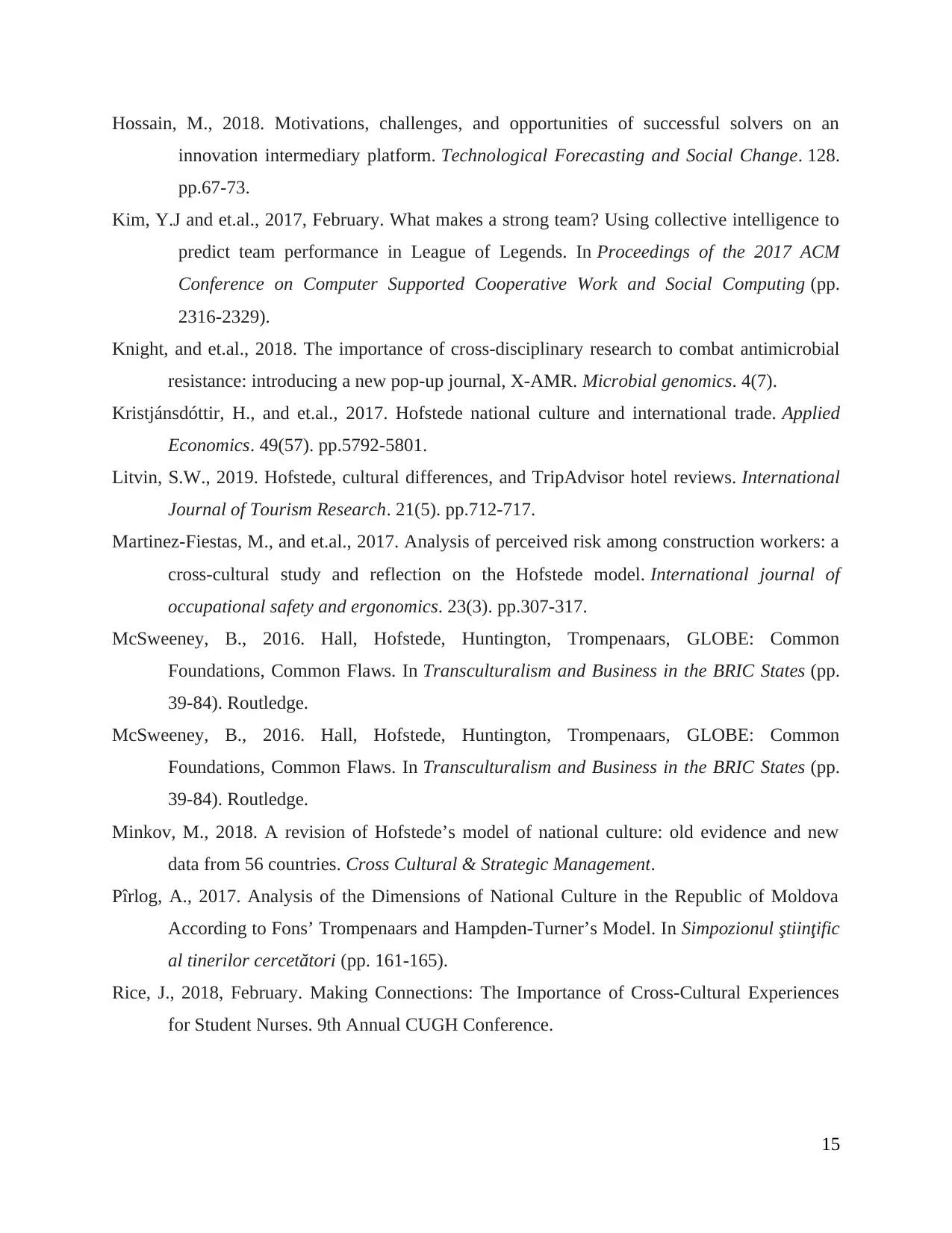
Hossain, M., 2018. Motivations, challenges, and opportunities of successful solvers on an
innovation intermediary platform. Technological Forecasting and Social Change. 128.
pp.67-73.
Kim, Y.J and et.al., 2017, February. What makes a strong team? Using collective intelligence to
predict team performance in League of Legends. In Proceedings of the 2017 ACM
Conference on Computer Supported Cooperative Work and Social Computing (pp.
2316-2329).
Knight, and et.al., 2018. The importance of cross-disciplinary research to combat antimicrobial
resistance: introducing a new pop-up journal, X-AMR. Microbial genomics. 4(7).
Kristjánsdóttir, H., and et.al., 2017. Hofstede national culture and international trade. Applied
Economics. 49(57). pp.5792-5801.
Litvin, S.W., 2019. Hofstede, cultural differences, and TripAdvisor hotel reviews. International
Journal of Tourism Research. 21(5). pp.712-717.
Martinez-Fiestas, M., and et.al., 2017. Analysis of perceived risk among construction workers: a
cross-cultural study and reflection on the Hofstede model. International journal of
occupational safety and ergonomics. 23(3). pp.307-317.
McSweeney, B., 2016. Hall, Hofstede, Huntington, Trompenaars, GLOBE: Common
Foundations, Common Flaws. In Transculturalism and Business in the BRIC States (pp.
39-84). Routledge.
McSweeney, B., 2016. Hall, Hofstede, Huntington, Trompenaars, GLOBE: Common
Foundations, Common Flaws. In Transculturalism and Business in the BRIC States (pp.
39-84). Routledge.
Minkov, M., 2018. A revision of Hofstede’s model of national culture: old evidence and new
data from 56 countries. Cross Cultural & Strategic Management.
Pîrlog, A., 2017. Analysis of the Dimensions of National Culture in the Republic of Moldova
According to Fons’ Trompenaars and Hampden-Turner’s Model. In Simpozionul ştiinţific
al tinerilor cercetători (pp. 161-165).
Rice, J., 2018, February. Making Connections: The Importance of Cross-Cultural Experiences
for Student Nurses. 9th Annual CUGH Conference.
15
innovation intermediary platform. Technological Forecasting and Social Change. 128.
pp.67-73.
Kim, Y.J and et.al., 2017, February. What makes a strong team? Using collective intelligence to
predict team performance in League of Legends. In Proceedings of the 2017 ACM
Conference on Computer Supported Cooperative Work and Social Computing (pp.
2316-2329).
Knight, and et.al., 2018. The importance of cross-disciplinary research to combat antimicrobial
resistance: introducing a new pop-up journal, X-AMR. Microbial genomics. 4(7).
Kristjánsdóttir, H., and et.al., 2017. Hofstede national culture and international trade. Applied
Economics. 49(57). pp.5792-5801.
Litvin, S.W., 2019. Hofstede, cultural differences, and TripAdvisor hotel reviews. International
Journal of Tourism Research. 21(5). pp.712-717.
Martinez-Fiestas, M., and et.al., 2017. Analysis of perceived risk among construction workers: a
cross-cultural study and reflection on the Hofstede model. International journal of
occupational safety and ergonomics. 23(3). pp.307-317.
McSweeney, B., 2016. Hall, Hofstede, Huntington, Trompenaars, GLOBE: Common
Foundations, Common Flaws. In Transculturalism and Business in the BRIC States (pp.
39-84). Routledge.
McSweeney, B., 2016. Hall, Hofstede, Huntington, Trompenaars, GLOBE: Common
Foundations, Common Flaws. In Transculturalism and Business in the BRIC States (pp.
39-84). Routledge.
Minkov, M., 2018. A revision of Hofstede’s model of national culture: old evidence and new
data from 56 countries. Cross Cultural & Strategic Management.
Pîrlog, A., 2017. Analysis of the Dimensions of National Culture in the Republic of Moldova
According to Fons’ Trompenaars and Hampden-Turner’s Model. In Simpozionul ştiinţific
al tinerilor cercetători (pp. 161-165).
Rice, J., 2018, February. Making Connections: The Importance of Cross-Cultural Experiences
for Student Nurses. 9th Annual CUGH Conference.
15
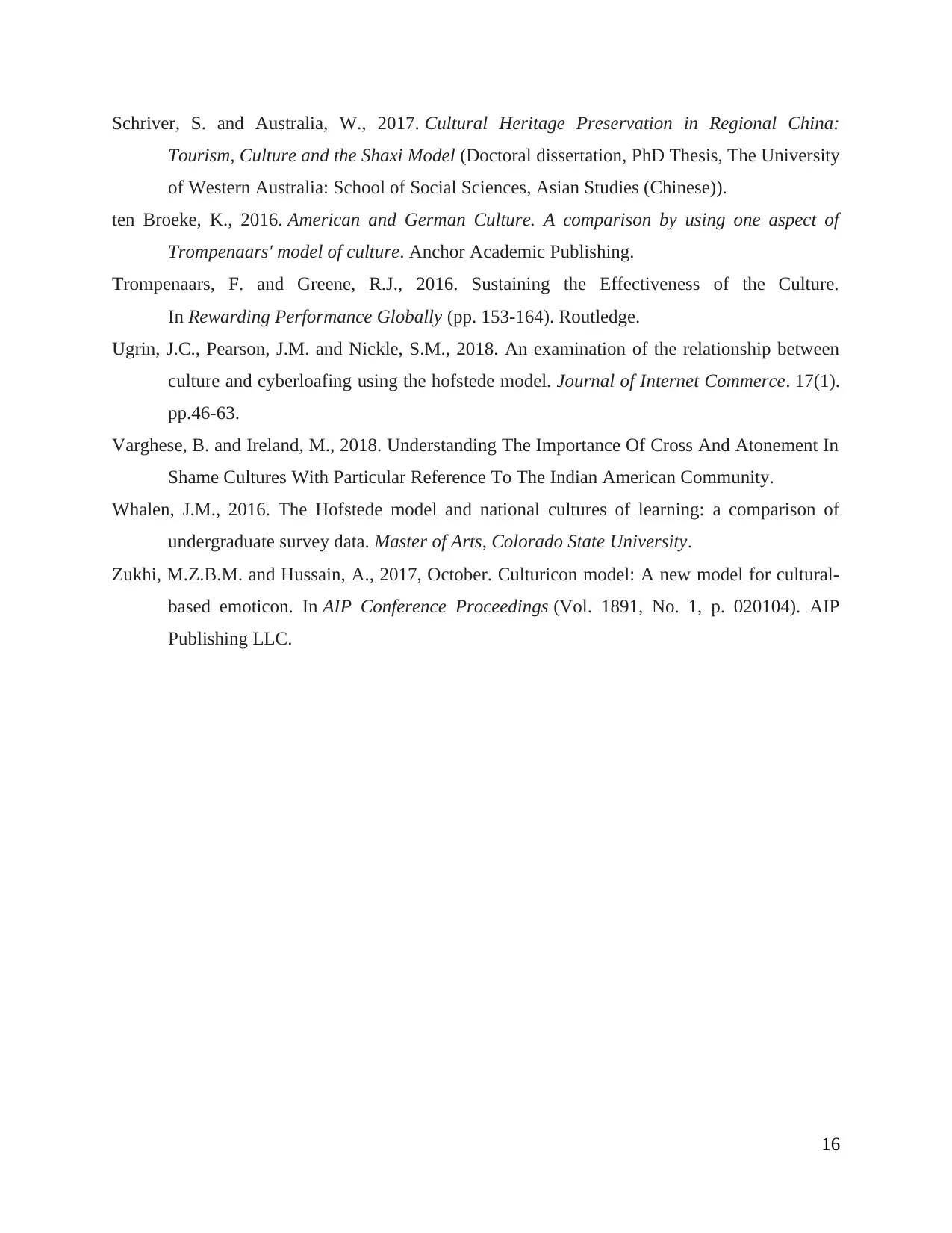
Schriver, S. and Australia, W., 2017. Cultural Heritage Preservation in Regional China:
Tourism, Culture and the Shaxi Model (Doctoral dissertation, PhD Thesis, The University
of Western Australia: School of Social Sciences, Asian Studies (Chinese)).
ten Broeke, K., 2016. American and German Culture. A comparison by using one aspect of
Trompenaars' model of culture. Anchor Academic Publishing.
Trompenaars, F. and Greene, R.J., 2016. Sustaining the Effectiveness of the Culture.
In Rewarding Performance Globally (pp. 153-164). Routledge.
Ugrin, J.C., Pearson, J.M. and Nickle, S.M., 2018. An examination of the relationship between
culture and cyberloafing using the hofstede model. Journal of Internet Commerce. 17(1).
pp.46-63.
Varghese, B. and Ireland, M., 2018. Understanding The Importance Of Cross And Atonement In
Shame Cultures With Particular Reference To The Indian American Community.
Whalen, J.M., 2016. The Hofstede model and national cultures of learning: a comparison of
undergraduate survey data. Master of Arts, Colorado State University.
Zukhi, M.Z.B.M. and Hussain, A., 2017, October. Culturicon model: A new model for cultural-
based emoticon. In AIP Conference Proceedings (Vol. 1891, No. 1, p. 020104). AIP
Publishing LLC.
16
Tourism, Culture and the Shaxi Model (Doctoral dissertation, PhD Thesis, The University
of Western Australia: School of Social Sciences, Asian Studies (Chinese)).
ten Broeke, K., 2016. American and German Culture. A comparison by using one aspect of
Trompenaars' model of culture. Anchor Academic Publishing.
Trompenaars, F. and Greene, R.J., 2016. Sustaining the Effectiveness of the Culture.
In Rewarding Performance Globally (pp. 153-164). Routledge.
Ugrin, J.C., Pearson, J.M. and Nickle, S.M., 2018. An examination of the relationship between
culture and cyberloafing using the hofstede model. Journal of Internet Commerce. 17(1).
pp.46-63.
Varghese, B. and Ireland, M., 2018. Understanding The Importance Of Cross And Atonement In
Shame Cultures With Particular Reference To The Indian American Community.
Whalen, J.M., 2016. The Hofstede model and national cultures of learning: a comparison of
undergraduate survey data. Master of Arts, Colorado State University.
Zukhi, M.Z.B.M. and Hussain, A., 2017, October. Culturicon model: A new model for cultural-
based emoticon. In AIP Conference Proceedings (Vol. 1891, No. 1, p. 020104). AIP
Publishing LLC.
16
1 out of 16
Related Documents
Your All-in-One AI-Powered Toolkit for Academic Success.
+13062052269
info@desklib.com
Available 24*7 on WhatsApp / Email
![[object Object]](/_next/static/media/star-bottom.7253800d.svg)
Unlock your academic potential
© 2024 | Zucol Services PVT LTD | All rights reserved.




